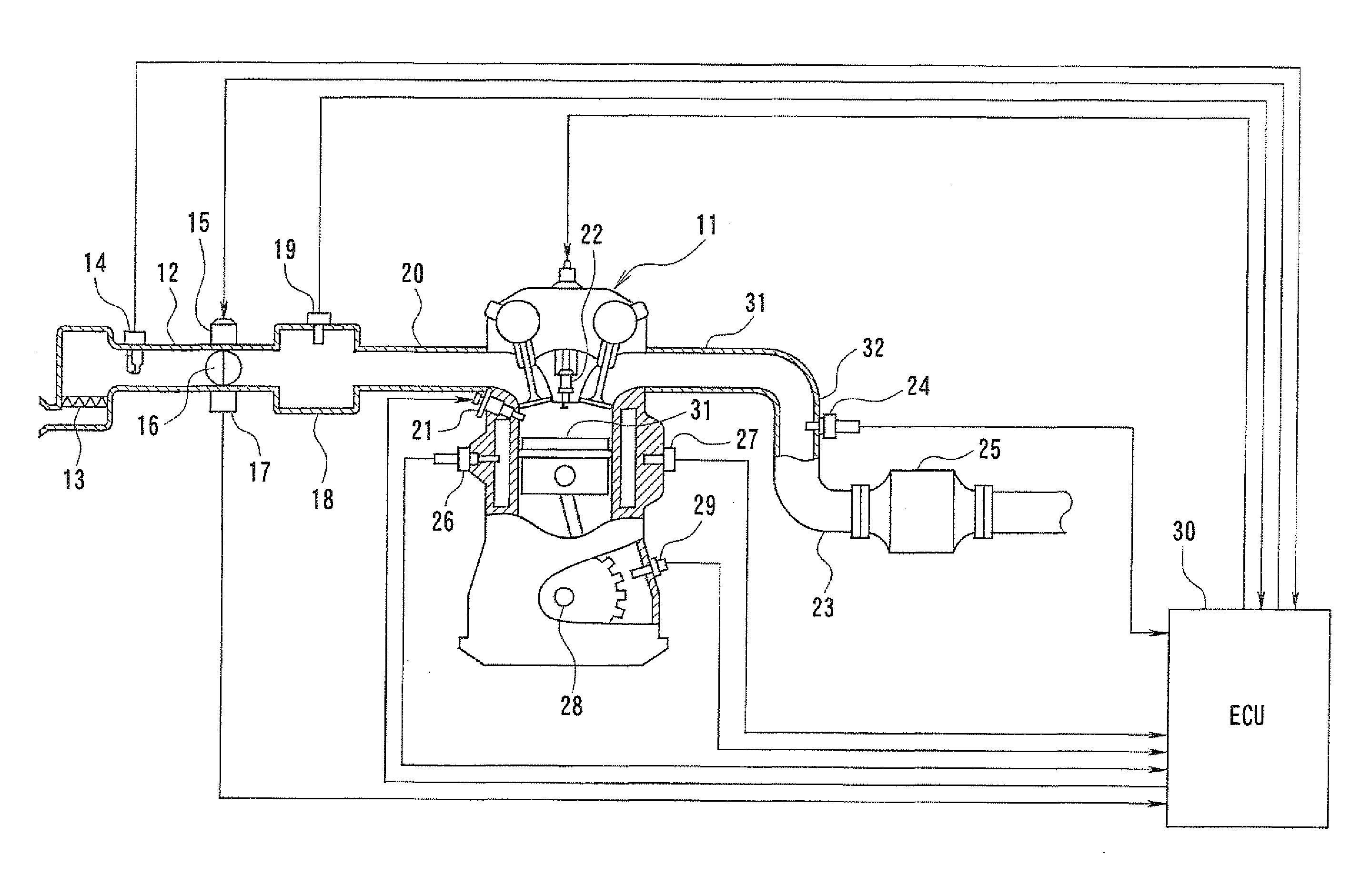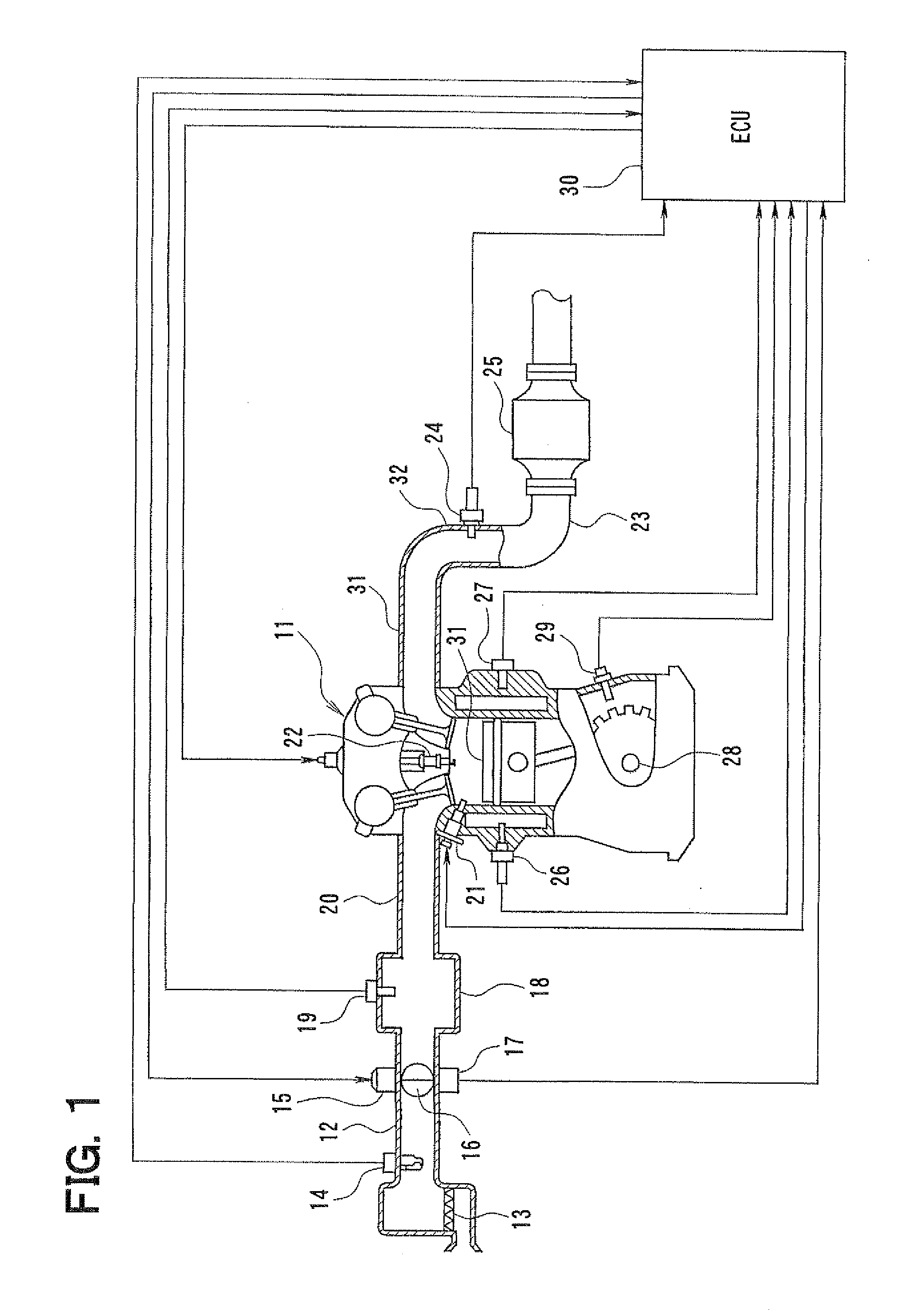Fuel injection controller for internal combustion engine
a fuel injection controller and internal combustion engine technology, applied in the direction of electrical control, process and machine control, etc., can solve the problems of deteriorating air-fuel ratio estimation accuracy, affecting the accuracy of air-fuel ratio detection, and affecting the accuracy of air-fuel ratio estimation with respect to each cylinder. , to achieve the effect of high accuracy, low engine load condition, and high accuracy
- Summary
- Abstract
- Description
- Claims
- Application Information
AI Technical Summary
Benefits of technology
Problems solved by technology
Method used
Image
Examples
first embodiment
[0031]Referring to FIGS. 1 to 4, a first embodiment will be described hereinafter.
[0032]FIG. 1 shows an engine control system. An air cleaner 13 is arranged upstream of an intake pipe 12 of an internal combustion engine 11 which is a direct injection engine. An airflow meter 14 detecting an intake air flow rate is provided downstream of the air cleaner 13. A throttle valve 16 driven by a DC-motor 15 and a throttle position sensor 17 detecting a throttle position (throttle opening degree) are provided downstream of the air flow meter 14.
[0033]A surge tank 18 including an intake air pressure sensor 19 is provided downstream of the throttle valve 16. The intake air pressure sensor 19 detects intake air pressure. An intake manifold 20 is connected to the surge tank 18. A fuel injector 21 is mounted on each cylinder at a vicinity of an intake air port in order to inject fuel into the cylinder directly. A spark plug 22 is mounted on a cylinder head of the engine 11 corresponding to each c...
third embodiment
[0076]Referring to FIGS. 7 to 10, a third embodiment will be described hereinafter.
[0077]FIG. 7 shows an engine control system according to the third embodiment. An air cleaner 113 is arranged upstream of an intake pipe 112 of an internal combustion engine 111 which is a direct injection engine. An airflow meter 114 detecting an intake air flow rate is provided downstream of the air cleaner 113. A compressor 128 of a turbocharger 126 and an intercooler 132 are provided downstream of the airflow meter 114. A boost pressure sensor 133 is provided downstream of the interceder 132 in order to detect boost pressure upstream of a throttle valve 116. The throttle valve 116 driven by a DC-motor 115 and a throttle position sensor 117 detecting a throttle position (throttle opening degree) are provided downstream of the boost pressure sensor 133.
[0078]A surge tank 118 including an intake air pressure sensor 119 is provided downstream of the throttle valve 116. The intake air pressure sensor 1...
fourth embodiment
[0102]Referring to FIG. 11, a fourth embodiment will be described hereinafter. In the fourth embodiment, the same parts and components as those in the third embodiment are indicated with the same reference numerals and the same descriptions will not be reiterated.
[0103]According to the present embodiment, the ECU 142 executes an injection-quantity variation learning routine shown in FIG. 11. The number N of split fuel injection is sequentially changed to learn the injection-quantity variation of the fuel injector 121, so that the injection-quantity variation is learned in multiple fuel injection quantity ranges.
[0104]In step 1201, the computer determines whether the engine driving condition (engine speed, engine load and the like) is stable. When the answer is YES in step 1201, the procedure proceeds to step 1202 in which the computer determines whether the engine is driven in high engine-load condition. When the answer is YES in step 1202, the procedure proceeds to step 1203 in whi...
PUM
 Login to View More
Login to View More Abstract
Description
Claims
Application Information
 Login to View More
Login to View More - R&D
- Intellectual Property
- Life Sciences
- Materials
- Tech Scout
- Unparalleled Data Quality
- Higher Quality Content
- 60% Fewer Hallucinations
Browse by: Latest US Patents, China's latest patents, Technical Efficacy Thesaurus, Application Domain, Technology Topic, Popular Technical Reports.
© 2025 PatSnap. All rights reserved.Legal|Privacy policy|Modern Slavery Act Transparency Statement|Sitemap|About US| Contact US: help@patsnap.com



